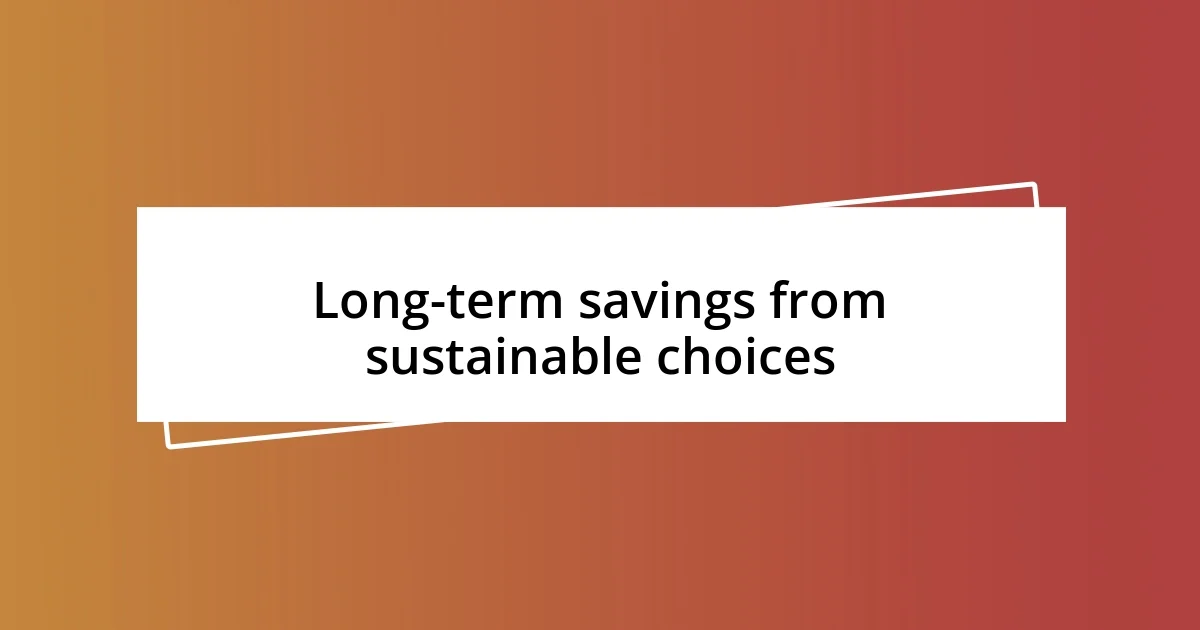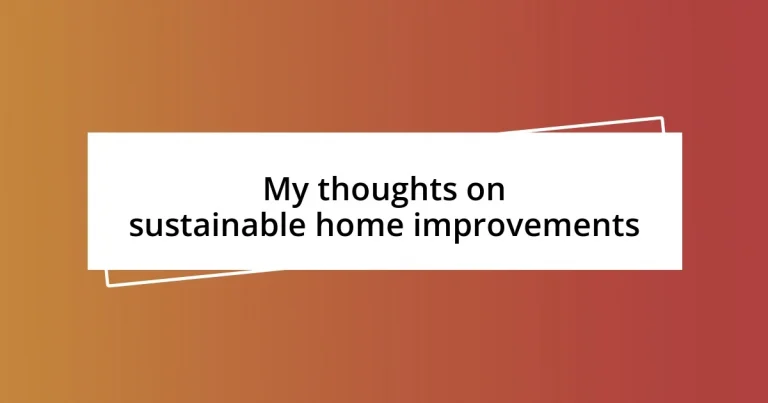Key takeaways:
- Sustainable home improvements enhance efficiency and reduce environmental impact, with decisions like using bamboo flooring and LED lighting reflecting personal values.
- Key benefits of sustainable upgrades include cost savings, lower carbon footprints, improved health, and increased home value.
- Long-term savings from energy-efficient appliances, durable materials, and solar panel installations provide financial benefits while contributing positively to the environment.

Understanding sustainable home improvements
Sustainable home improvements fundamentally revolve around enhancing a home’s efficiency while minimizing environmental impact. I remember when I decided to replace my old windows; it was a surprisingly emotional journey. Watching the energy bills drop felt rewarding, but it also made me consider how small changes can create a ripple effect toward a healthier planet.
One question that often comes to mind is, “How can we make our living spaces not just better for us, but for the Earth as well?” From my perspective, understanding sustainable options means recognizing that every decision counts. For instance, opting for bamboo flooring instead of traditional hardwood isn’t just about aesthetics; it’s a choice that reflects a commitment to sustainability, considering bamboo is rapidly renewable.
When I think about sustainable improvements, I realize they’re more than just upgrades; they reflect our values and priorities. Transitioning to LED lighting lit up my home both literally and metaphorically. It struck me that each flick of a switch brings me closer to living in harmony with nature—lifestyle shifts that illustrate just how impactful our choices can be.

Benefits of sustainable home upgrades
Upgrading to sustainable features in our homes brings a multitude of benefits, both for our wallets and the environment. I remember when I installed solar panels; the initial investment felt daunting. However, over time, the energy savings have been substantial, and the knowledge of harnessing sunlight for power gives me a profound sense of satisfaction. It’s as if my home is not only a shelter but also a contributor to the greater good.
Here are some key benefits of sustainable home upgrades that resonate with me:
- Cost Savings: Reduced energy bills can lead to significant savings over time.
- Environmental Impact: Lower carbon footprint contributes positively to the planet.
- Comfort and Health: Improved air quality and insulation create a healthier living space.
- Increased Home Value: Eco-friendly homes often attract higher resale prices.
- Resource Efficiency: Utilizing renewable resources promotes sustainable living practices.
Every time I see those solar panels glimmer in the sun, I’m reminded that making green choices can be rewarding on multiple levels. It’s not just about the money saved; it’s about making a tangible difference in my daily life and the world around me.

Eco-friendly materials to use
When considering eco-friendly materials, one option I find incredibly appealing is reclaimed wood. I once renovated my dining room using reclaimed barn wood, and not only did it add character to my space, but it also sparked conversations about sustainability during family dinners. This material is a beautiful reminder that we can give new life to what once was and reduce waste at the same time—definitely a win-win in my book.
Another eco-friendly choice is recycled glass for countertops or tiles. I remember visiting a friend’s home where they had installed stunning countertops made from recycled glass. It was both eye-catching and had a story behind it, which added a layer of meaning to the kitchen. Using recycled materials like this helps divert waste from landfills and encourages innovative design, making it a smart choice for anyone looking to create an impactful statement.
Moreover, I can’t overlook the benefits of natural insulation materials, such as sheep’s wool or cellulose made from recycled paper. I recently insulated my attic with cellulose, and the improvement in temperature regulation was noticeable. It felt great knowing that I was not only improving my home’s energy efficiency but also using biodegradable materials that reduce the overall environmental impact of my home.
| Material | Benefits |
|---|---|
| Reclaimed Wood | Adds character, reduces waste, supports sustainable forestry |
| Recycled Glass | Visually stunning, diverts waste from landfills, encourages eco-friendly design |
| Natural Insulation (e.g., Sheep’s Wool, Cellulose) | Improves energy efficiency, biodegradable, better indoor air quality |

Energy-efficient appliances and systems
When I replaced my old appliances with energy-efficient models, it felt like I was giving my home an upgrade while also making a commitment to the planet. The new refrigerator not only uses less energy—saving me money on my bills—but it also runs quietly and keeps my food fresher longer. Have you ever noticed the difference in sound and functionality? It’s remarkable how a small change can enhance daily life.
I’ve also invested in smart thermostats, which have truly transformed the way I manage my home’s temperature. These devices learn my habits and adjust heating and cooling accordingly, resulting in remarkable energy savings. I still remember the moment I noticed a significant drop in my monthly utility bill; it felt like I had discovered a hidden treasure. The blend of technology and eco-friendliness creates a comfortable environment without harming the earth—how could anyone not get excited about that?
Let’s not forget about energy-efficient lighting—by switching to LED bulbs, I retired the old incandescent ones that always seemed to burn out at the worst times. I find it satisfying to walk into a room and instantly enjoy the bright, vibrant light without worrying about replacing bulbs every few months. It’s such a small tweak that can make a huge difference in how I feel in my home, not to mention the reduced energy consumption. It’s little wonders like these that remind me how easy and fulfilling it is to integrate sustainability into everyday living.

Water conservation strategies for homes
Water conservation is a hot topic in today’s world, and I’ve found that even small changes at home can make a significant impact. One simple trick I employ is turning off the tap while brushing my teeth. I remember the first time I realized that this little act could save gallons of water daily. It’s comforting to know that my nightly routine not only keeps my teeth clean but also contributes to broader conservation efforts—talk about a double win!
Another strategy I’ve adopted is capturing rainwater for outdoor use. I installed a rain barrel earlier this year, and it has transformed how I water my garden. It felt amazing the first time I used that collected rainwater, knowing I was giving my plants the nourishment they need without tapping into the municipal supply. Plus, it’s a budget-friendly way to keep my garden thriving while lessening my environmental footprint.
Lastly, I’ve embraced water-efficient fixtures, like low-flow showerheads and dual-flush toilets. I was pleasantly surprised by how much water I saved each month without sacrificing performance. I’ll never forget the day I noticed my water bill had dropped significantly. It’s a simple home upgrade that benefits my wallet and the planet, reminding me that conservation can be stylish and practical, all at once. Have you considered making these small yet impactful improvements in your own home?

DIY sustainable home projects
One of my favorite DIY sustainable home projects has been creating a compost bin in my backyard. I remember the excitement of turning kitchen scraps into nutrient-rich soil; there’s something profoundly satisfying about seeing my waste transform into something so beneficial. Have you ever felt that connection to nature when you dig into the earth and see your compost make a difference? It’s an empowering project that not only improves my garden but also reduces the amount of waste I send to the landfill.
Another rewarding project was installing a small vertical garden on my patio. I got inspired after seeing how much joy greenery brings to a space. The first time I harvested fresh herbs for cooking, I couldn’t help but smile. It reminded me that sustainability can taste good, too! Plus, growing my own food has not only saved me money but also ensured I know exactly where my ingredients come from—what’s more sustainable than that?
Lastly, I experimented with making homemade cleaning products using simple ingredients like vinegar and baking soda. I was hesitant at first, thinking cleaning had to be complicated. However, shaking up a bottle with just a few eco-friendly ingredients felt like both a scientific experiment and a step towards reducing my plastic waste. Have you tried it? The freshness of naturally-sourced scents has completely replaced the chemical-heavy products I used to rely on; it’s truly a breath of fresh air for my home and my health.

Long-term savings from sustainable choices
Long-term savings from sustainable choices can be quite eye-opening. I’ll never forget the moment I realized my energy-efficient appliances not only reduced my carbon footprint but also lowered my monthly bills. After replacing my old fridge with an Energy Star model, I was pleasantly surprised to see my energy bill drop by nearly 20%. It felt like a little victory for both my wallet and the environment. Have you thought about how much long-term savings you could see from similar upgrades?
Investing in sustainable materials for home improvements can also lead to significant savings down the line. When I switched to bamboo flooring, I was initially drawn in by its aesthetic appeal. But, weeks later, when I noticed how easy it was to maintain and its incredible durability, I realized I’d made a smart choice. Not only did it elevate my home’s look, but the longevity and minimal upkeep requirements meant fewer replacements and repairs for me. Isn’t it amazing how one choice can ripple through your home’s lifecycle?
Moreover, the return on investment for solar panels is something I find incredibly encouraging. after a bit of research, I decided to install them last summer, and I still remember the rush of excitement seeing my first energy bill post-installation. The significant savings and tax incentives have already made the decision worthwhile. It’s like having a little money tree that also helps me contribute to a cleaner planet. Have you ever considered how these upfront costs can translate into lasting financial benefits?












